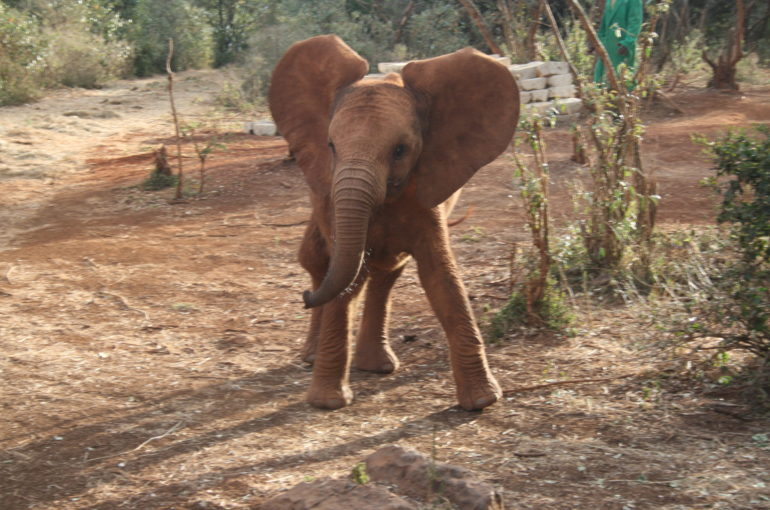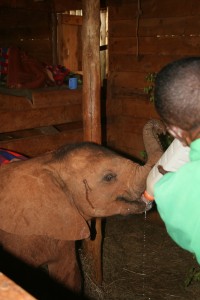Fostering an elephant in Kenya

Fostering an elephant in Kenya and returning it to the wild helps reverse the drastic effects of poaching
MEET Naipoki, the newest member of our family.
She was three months old when she fell down a well in the Namunyak Conservancy in northern Kenya. Unable to be helped by her real family, she was rescued and brought to The David Sheldrick Wildlife Trust. She has been there since October 2010.
I visited this amazing place on the outskirts of the capital, Nairobi and chose Naipoki when I signed up for the Baby Elephant Foster Parent Program.
For $50 a year, you become a foster parent; receive an interactive map of where your orphan was found and a description of the plight of elephants and rhinos in that area; a monthly summary of what your elephant has been up to; and a direct link to the Keeper’s Diary.
Baby elephants need a lot of support
Each animal has more than one sponsor – a lot of money needs to be raised – so I am one of Naipoki’s many foster parents. The Keeper’s Diary has photos and lets you know about significant dates on Naipoki’s social calendar. I’m not sure exactly what an elephant’s diary looks like. Perhaps it has all her play dates marked down. I guess I will find out next month.

Baby elephants are needy creatures. For a start, they are bottle fed every three hours. The keepers sleep with them in their stables and get only one day off a month. In reality, the keepers are replacing the emotionally fragile baby’s lost family.
The keepers put blankets on the babies when it is cold, they put raincoats on them when it’s wet and apply sunscreen (SPF 30) on sunny days. In the wild, their mothers would do all this.
Before you ask, a baby elephant’s ears are susceptible to sunburn, and in the wild a mother licks the baby’s ears, producing something like sunscreen.
Twice a day, people can visit The David Sheldrick Wildlife Trust to see the elephant parade. I doubt many leave without becoming foster parents.
A stampede
When you arrive, the stables are empty and there is not an elephant to be seen. There were about 20 of us – five Australians – there on the afternoon we visited. We were told to line up on the edge of the bush because the elephants were ready for us.
Then the baby elephant walk began. The only thing missing was the bouncy sounds of the Henri Mancini tune from the movie Hatari!
These babies, some with machete wounds in their backs, charged into the compound like a class escaping a maths lesson. They headed straight for the stables.
Dinner time is hilarious to watch
It was dinner time and we all laughed as they inhaled their milk as fast as possible. There were bottles flying everywhere until the last drop of the magic formula made by Wyeth Laboratories had disappeared.
After that it was time for the next batch of elephants. They were slightly older. They charged past us, dust filling the air, toward their stables. One missed its turn and when he realised he was lost, started throwing a tantrum not unlike a child.
The trust was set up in 1977 to honour the memory of David Sheldrick. Dame Daphne Sheldrick has been a vocal campaigner for animal rights in Kenya and the trust is known for rescuing, raising and returning elephants and rhinos to the wild. It is not a zoo in any way, shape or form. Every decision, and every dollar raised, goes toward getting these animals back to the habitat in which they belong. So far, more than 130 elephants have been returned to the wild.
The elephants stay in Nairobi until they are two, when they are moved to Tsavo East National Park with their keepers, where they are introduced to wild herds and the assimilation process begins.
Time to go wild
Elephants make the decision on when they “go wild”. And many often return to their human families in the camp from time to time.
As we know, elephants have amazing memories so when they return they will seek out their original handlers.
The Tsavo area elephant population peaked at 45,000 in the late ’60s. Two decades of poaching and slaughter later, the population had been drastically reduced. Today, it is once again on the increase, thanks to people such as Daphne Sheldrick and her foundation.
Elephant numbers on the rise
In 2008, there were 11,696 elephants in the area. By last year, that number had risen to 12,572. A small, but important, step.
Poachers are still active. There is growing demand for ivory from countries such as China, Vietnam and Thailand. There are calls for African governments to be much tougher on poachers than they are.
I was told, though, that one tusk sold to China will get a Kenyan poacher enough money to feed his family for 10 years. So you can understand why people are still prepared to poach.
So back to Naipoki, who will soon be heading out into the wild. It took about 20 minutes to do the foster parent sponsorship. After I’d filled in all the forms, I went back to check on my new baby.
She was fast asleep. Her handler had put a rug on her and she was oblivious to the fact that she now had three sisters back in Australia.
To learn more about the trust, go to sheldrickwildlifetrust.org.

